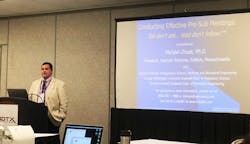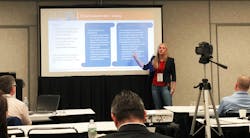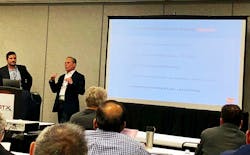Design Insights and Lessons from the Workshops at MDTX
For those design engineers entering the medical device world, the workshops at the Medical Device Technology Exchange (MDTX) 2018 provide great insight on how to navigate the difficult field of designing medical devices. Just like other fields of engineering, there are different regulations, protocols, and testing that have to be performed prior to a product entering the market. For example, designs for buildings and bridges must be signed and approved by a licensed Professional Engineer before construction begins. Medical devices have their own approval system and testing. Here are some of the insights provided at the conference.
Adhere to Medical Device Standards
Jon Speer, founder and vice president of Greenlight Guru, discusses the differences between the ISO13485:2016 and the FDA 820 standards.
Design standards govern engineers and how they can construct their products. For mechanical engineers, the ASMEY14.5 is the golden standard for drawings and tolerances of new products. Just like the mechanical world, the medical engineering world has to adhere to strict standards to ensure the safety of medical products. At the MDTX Conference, Jon Speer, founder and vice president of Greenlight Guru, hosted a workshop on how to navigate the two important standards for medical devices: the ISO 13485:2016 and the Food and Drug Administration (FDA) 820.
Speer highlighted the history of the ISO 13485:2016. It evolved out of the general quality management system standard ISO 9001 and is specific to the medical device industry. The standard has been internationally agreed upon and defines a way to address common regulatory concepts. While technically not law, the ISO standard has set the rules which all companies and governments adhere to for medical device approval.
Adherence to ISO 13485 is not explicitly required, but there are several benefits of doing so. Adhering to the standard improves the likelihood that a medical device company will meet customer and regulatory requirements, and achieving ISO 13485 certification offers assurance that a company meets certain quality management system expectations defined within the standard. The major update to the ISO13485 released last year was the added sections addressing risk management and security.
The FDA 21 CFR Part 820 Quality System Regulations is the U.S. counterpart to the ISO 13485. It is the law for medical device companies manufacturing and selling products for the U.S. market. Anyone designing medical devices for both the U.S. and international market will need to pass both achieve the ISO13485 certification and FDA 820 approval. Greenlight Guru offers an electronic software that helps designers navigate both standards, providing an application based format to achieve certification. It helps compare the two standards and assist the engineers in providing the correct documentation.
How to Deal with the FDA?
Michael Drues, Ph.D., is a consultant who helps medical device companies seek FDA approval.
Michael Drues, Ph.D., is president of Vascular Sciences and an adjunct professor at George Washington University and Cornell University. He is also a consultant for companies looking to get their medical devices approved with the FDA. Drues advises on how to successfully submit your device approval documentation by meeting with the FDA prior to the official submission.
A design engineering company on the road toward submitting its materials for approval to the FDA can request a pre-submission (pre-sub) meeting with the agency. A pre-sub meeting is just what it sounds like. The engineers of the medical device sit down with representatives of the FDA to discuss the technical background, design, and testing of your medical device.
The medical engineering company must submit a 510(K) when looking for device approval. A 510(K) is a premarket submission made to FDA to demonstrate that the device to be marketed is at least as safe and effective—that is, substantially equivalent—to a legally marketed device that is not subject to premarket approval. 95% of all 510(K)s are rejected upon first submission. By having a pre-sub meeting with the FDA, one can avoid having their 510(K) rejected and claim an important milestone for their device—crucial for investors.
How to Plan a Clinical Evaluation
Anne Leijsen is a medical writer for Factory CRO and has successfully submitted several clinical evaluation reports for approval.
A new revision to the MEDDEV 2.7/1 Rev. 4 guideline in June 2016 changed how clinical evaluation reports were approved in the European Union. The change was connected to the introduction of the EU MDR enacted in 2017 and will impact the procedures surrounding post-market clinical information, device equivalence, and clinical evidence for medical device companies.
Anne Leijsen, a medical writer for Factory CRO, and Gish Consulting’s Christine Zomorodian provided insight at the show on how to properly plan a clinical evaluation report. Zomorodian detailed the process of designing a clinical evaluation structure. The new submission standards have an increased focus on post-market medical device data, and clinical evaluations have become a focus of notified body review efforts. People in attendance learned when to perform certain steps, such as when should your clinical evaluations be performed or what information needs to be collected.
Leijsen helped the attendees understand what information is needed in the creation of clinical evaluations. Having worked on numerous clinical evaluation reports in the past, she provided insight on what the focus of report should be, data to be captured, and to overcome obstacles such as the lack of data and show be involved in the clinical evaluation process. By way of example: For those engineers who have successfully achieved ISO 13485 certification, the FDA is now accepting all test data performed under the ISO for their approval process.
Advice for Medical Device Startups
Tor Alden and Bobby Boyer are consultants for HS-Design. They help startup medical device companies with their design plans, seek out investors, and navigate the FDA approval process.
Tor Alden and Bobby Boyer are consultants with HS-Design. Their job is to help engineers, doctors, and entrepreneurs enter the medical device world. There is an increased demand for new devices ranging from combination products to medical devices. Products are crossing boundaries from pharmaceutical and biologic delivery systems, forcing a need for increased collaboration in the design of complex systems in the medical and life science device development. For a typical startup, this means balancing the technology with usability.
Alden and Boyer stressed that there is a need to capture a wide variety of technical and user information that is used by various disciplines including engineering and marketing. One of the more insightful pieces of advice they offered was to identify common mistakes startups make when entering the device field:
Not performing market research. Designers who build their devices in a bubble and ignore the customer’s needs fail on their design, and struggle with investors and approval.
Lack of understanding regarding intellectual property (IP) law. Any designer of a device should seek out a utility or design patent on their device. This helps protect your ideas as you start to promote your design.
Not seeking regulatory assistance early in the design. Startups should look for experienced consultants who understand the standards and regulations. This will help with FDA approval down the road.
No usability studies. By not performing the necessary testing with users, the startup will have a rough road seeking medical device approval.
Underestimating cost and timelines. A lack of funding and understanding of the production build impact many startups. Be sure to conduct the proper research into how long your device will take to manufacture, and how much it will cost.





